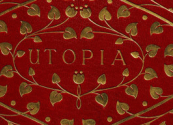Pneuma: From Magic to Mechanism
by Patrick Smyth, PhD
In my readings of utopian texts this semester I have been sensitive to the aesthetics of science—that is, our subjective perception of science and the means by which this perception colors our interpretation of the world. By the nineteenth century, a scientific aesthetic had become relatively fixed, partly due to the obvious physical presence of a number of disruptive technologies such as steam power, electricity, and applied chemistry. As we have seen, however, subjective perceptions of science in the seventeenth century were much more fluid. Depending on the observer, natural philosophy could be a social force that upheld fixed hierarchies, as in Bacon’s New Atlantis, or could facilitate a more disruptive epistemology, as in Cavendish’s Blazing World. This indeterminacy is similar to the unfixed quality we’ve observed in discourses about race from the period, and differs profoundly from the relatively fixed stereotypes about “projectors” and “antiquarians” that emerge in the eighteenth century.
One central concept that might serve as a locus for these general observations is air. Natural philosophy in this period is deeply concerned with pneuma, a Greek concept that meant “wind” or “sprit” and was often used to describe the breath, as in our modern “pneumonia.” Early modern texts approached air in ways that often conjoined the spirit, as in “numinous”—and the element of air, as in the case of the New Atlanteans being taken for “a land of magicians, that sent forth spirits of the air into all parts, to bring them news and intelligence of other countries.” A similar conception of pneuma is given in the interactions between Prospero and Ariel in The Tempest, published about sixteen years before New Atlantis. By the mid-1600s, Cavendish is still clearly influenced by these conceptions of early modern magic—most clearly in her interactions with “disembodied spirits”—but this portrayal of air and spirit is elaborately justified by the scientific theories laid out in her Observations.
Fundamentally, early modern science was as much about explicating spiritual phenomena as it was about exploring physical laws. Indeed, Cavendish and others explicitly conflate the two, contending that the spirit was a material entity. Most interesting to me, however, is the alteration that takes place between this period and the early eighteenth century. Swift strives to explode the validity of both science and spirit in Gulliver’s Travels—literally, in the case of the dog fatally subjected to inflation by a set of bellows and left to be resuscitated “by the same operation.”
For my paper, I intend to trace these conjoined concepts of spirit and air. I’ll also be drawing on Hook and Boyle’s (often gruesome) experiments with vacuum chambers and the investigations of van Helmont, the originator of the term “gas,” into pneumatic chemistry and vitalism. I haven’t nailed down the exact angle I’ll take, but I’m starting to get a sense of the means by which this conception of pneuma changed from the late sixteenth to the early eighteenth century, and I’m looking forward to investigating further.



Pneuma! This is fantastic…so glad you are working on this. Yes, you need to nail down the exact angle, so I’ll want to hear more about that tomorrow. How are you working to zero in on this topic? I imagine it’s a process of reading, reading, reading for the moment…